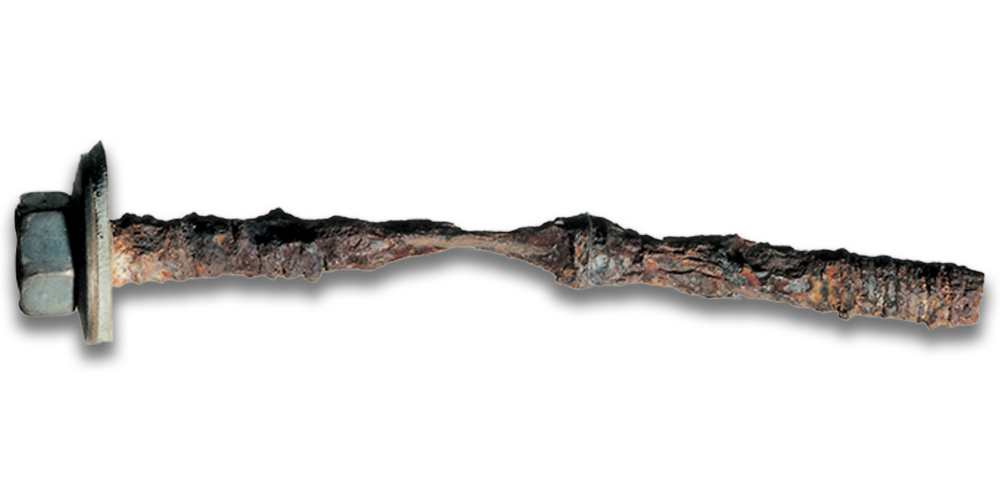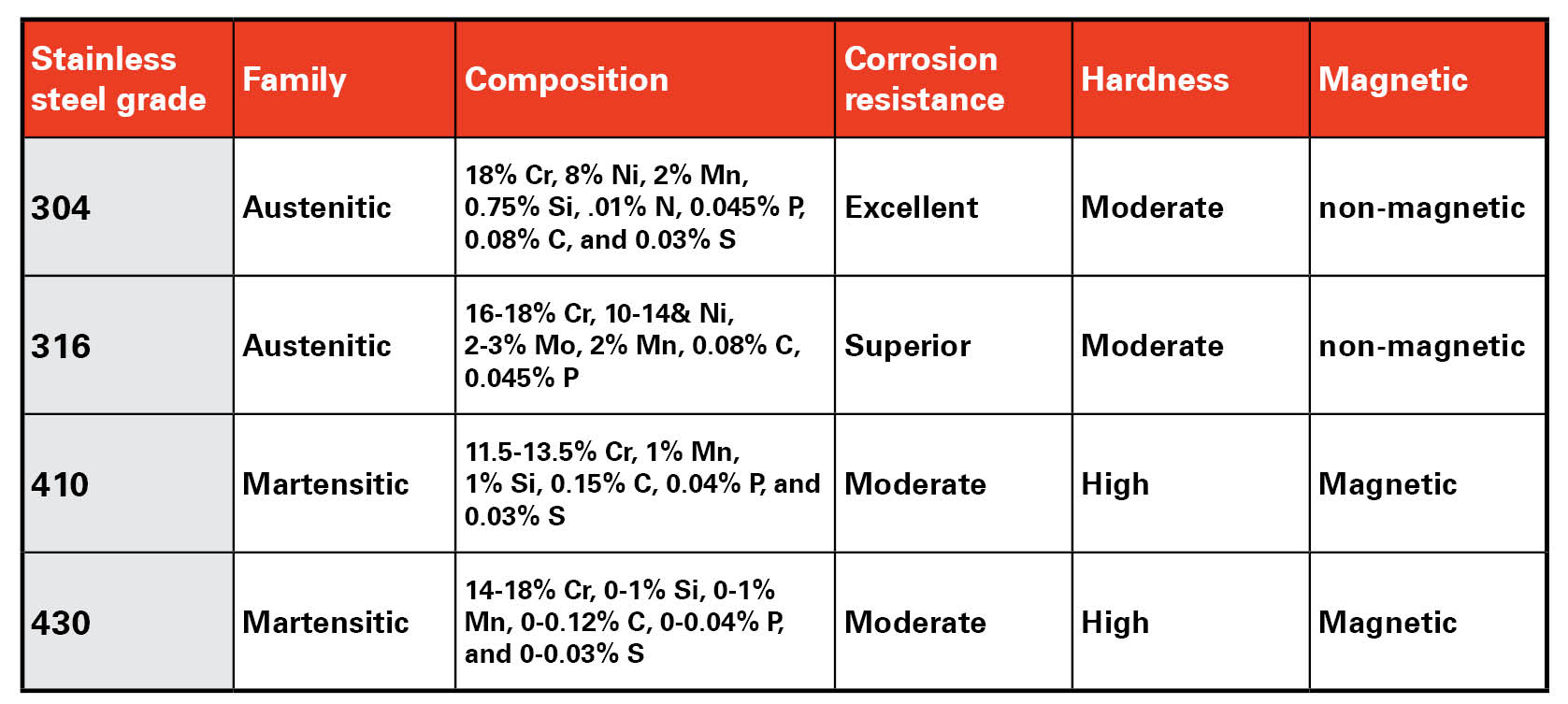300 series stainless steel vs. 400 series screws
For fastener applications, when stainless steel is seen in a specification or recommendation, it’s most likely referring to 400-series or 300-series alloys. While both are incredibly strong and offer respectable rust resistance, there are game-changing distinctions between the two. Moreover, important differences exist within the series themselves, such as 316 from 304.
In this article, we’ll highlight how 300 and 400 stainless steels compare in regard to composition, performance, and pricing to help you ultimately determine the best option for your next commercial build. Scroll down to gather more information by watching our screw science video!

What defines 300 vs 400 stainless steel series?
You may also see 400-series referred to as martensitic stainless steel and 300-series referred to as austenitic stainless steel. The biggest difference between these groups of alloys is the chemical composition (the ratio of different elements that create the metal). More specifically, the two groups of alloys have varying amounts of chromium and nickel.
304 stainless steel, the most common alloy for 300-series fasteners, contains around 50% more chromium than 410 stainless steel, the most common alloy for 400-series stainless steel fasteners. While 410 stainless steel does not contain any nickel, nickel makes up around 10% of the total composition of 304 stainless steel.
Though chromium and nickel are the primary differentiators of 400-series and 300-series stainless steels, molybdenum can be added to 304 stainless steel to create 316 stainless steel, making up around 2.5% of the total composition.
The important thing to remember is that both chromium and nickel work together in stainless steel to increase corrosion resistance.

Austenitic stainless steels (300-series) contain austenite and are made by heating ferrite to 1673ºF. While austenitic stainless steel cannot be hardened through heat treatment, martensitic steel can. Martensitic steel is preferable over austenitic when hardness is a priority.
How 300 series screws compare to 400 series for corrosion strength
410 stainless steel offers mild corrosion resistance thanks to its chromium content, and is commonly used in applications where the fasteners will not be exposed to constant moisture or any chemicals. An example of an application where 410 stainless steel may be used is metal wall panel attachment.
However, 304 stainless steel offers some of the best corrosion properties that are available for fasteners thanks to the amount of chromium and nickel that are in the alloy. 304 stainless steel can be used in the presence of a variety of chemicals and acids; including lower concentrations of chlorides (salt)When choosing a fastener that will regularly come in contact with moisture, chemicals, animal waste, and low concentrations of salt, 304 stainless steel is the best option!
With the addition of the molybdenum, 316 stainless steel becomes much more resistant to chlorides and harsher chemicals, especially when compared to 410 and 304. When choosing a fastener that will come in contact with chemicals such as sulfuric acids and higher concentrations of salt that are present within 1km of the ocean, 316 stainless steel is the best commercially available option!
In summary, both 304 and 316 offer superior resistance from corrosion than 410. However, there are stainless steels available with even better corrosion resistance, like 1.4547, which is particularly good for highly corrosive environments, especially in sea water, hydrochloride or sulfuric acid environments.Which type of stainless steel is stronger - 300 or 400?
Because of the differences in composition, 400-series stainless steels can be heat treated to higher hardnesses while 300-series stainless steels cannot. This enables 410 stainless steel fasteners to be much harder than any 304 and 316 stainless fastener, and thus stronger. In applications where ultimate tensile or shear strength is critical, 410 stainless steel fasteners may be preferred.
How does pricing compare between 300 series stainless vs. 400?
Simply comparing raw materials, 304 stainless steel is around 50% more expensive than 410 stainless steel (and 316 is more costly than both). In turn, this often results in most 300-series fasteners being more expensive than their 400-series counterparts. Therefore, we often direct customers towards 400 stainless steel if the anticipated exposure to corrosive elements is low.
However, in scenarios in which external corrosive elements will be high, we encourage buyers to think of the long-term savings that come from fasteners with inherent resistance to rust (304 or 316) rather than those which will compromise the integrity of the build.
Don’t forget about galvanic corrosion when choosing a stainless steel screw
One topic that is often overlooked during fastener selection is galvanic corrosion, specifically when aluminum is used. When a fastener is being used in an application where aluminum is present, extra caution needs to be taken to limit galvanic corrosion within the connection.
Galvanic corrosion is caused when dissimilar metals come in contact with an electrolyte, like water. If this is not prevented, a phenomenon called hydrogen-assisted stress corrosion cracking can occur which essentially causes cracking of hardened steel, like hardened 410 stainless steel. Due to the lower hardness of 304 stainless, which may have seemed like a hindrance, actually means that it is immune to this phenomenon. Therefore, when aluminum is present in an application, 304 stainless steel is the best choice for fastener material.
How do 300 and 400 stainless steels compare regarding magnetic properties?
300-series stainless steel is typically not magnetic due to its nickel content. 316 stainless steel is not magnetic whatsoever. However, 304 stainless steel has a lower nickel content and may be mildly magnetic. Meanwhile, 400-series stainless steel is slightly magnetic, since it lacks nickel.
This isn’t a significant deciding factor when selecting a stainless steel fastener. The only potential impact is how well a magnetic nut setter would retain a faster. In this case, 300 series stainless steel’s slight magnetism could make it slightly more challenging to retain a magnetic bit.
In summary: Pros and cons of 300 and 400 stainless steels
300-series stainless steel pros
Superior corrosion resistance when compared to 400-series stainless steel
300-series stainless steel cons
More expensive upfront than 400-series stainless steel fasteners
400-series stainless steel pros
More affordable than 300-series stainless steel fasteners
Harder and stronger than 300-series stainless steel
Improved performance at higher temperatures
400-series stainless steel cons
Inferior corrosion resistance compared to 300-series stainless steel
Find the right stainless steel screw with SFS: 304, 316, 410, and beyond
We manufacture a full range of 400-series and 300-series fasteners, including the ever-popular bi-met screw and our 316 stainless steel fasteners. Browse our online selection or contact us at (800) 234-4533 to speak with a specialist about which stainless steel best fits your particular project.
Examples of 300-series stainless steel fasteners
We offer a wide variety of 300-stainless steel fasteners in both 304 and 316.
Curious to learn more? We suggest reading 304 vs 316 stainless steel screws - strength, corrosion resistance, and cost.
Examples of 400-series stainless steel fasteners
Whether you seek a 304, 410 or another kind of steel for your commercial projects’ fasteners, our team is ready to help. Contact our specialists to get started.

 English (Canada)
English (Canada)
 čeština (Česká republika)
čeština (Česká republika)
 magyar (Magyarország)
magyar (Magyarország)
 Deutsch (Deutschland)
Deutsch (Deutschland)
 eesti (Eesti)
eesti (Eesti)
 español (España)
español (España)
 português (Portugal)
português (Portugal)
 suomi (Suomi)
suomi (Suomi)
 français (France)
français (France)
 English (United Kingdom)
English (United Kingdom)
 italiano (Italia)
italiano (Italia)
 Nederlands (Nederland)
Nederlands (Nederland)
 norsk, bokmål (Norge)
norsk, bokmål (Norge)
 polski (Polska)
polski (Polska)
 svenska (Sverige)
svenska (Sverige)
 Türkçe (Türkiye)
Türkçe (Türkiye)

